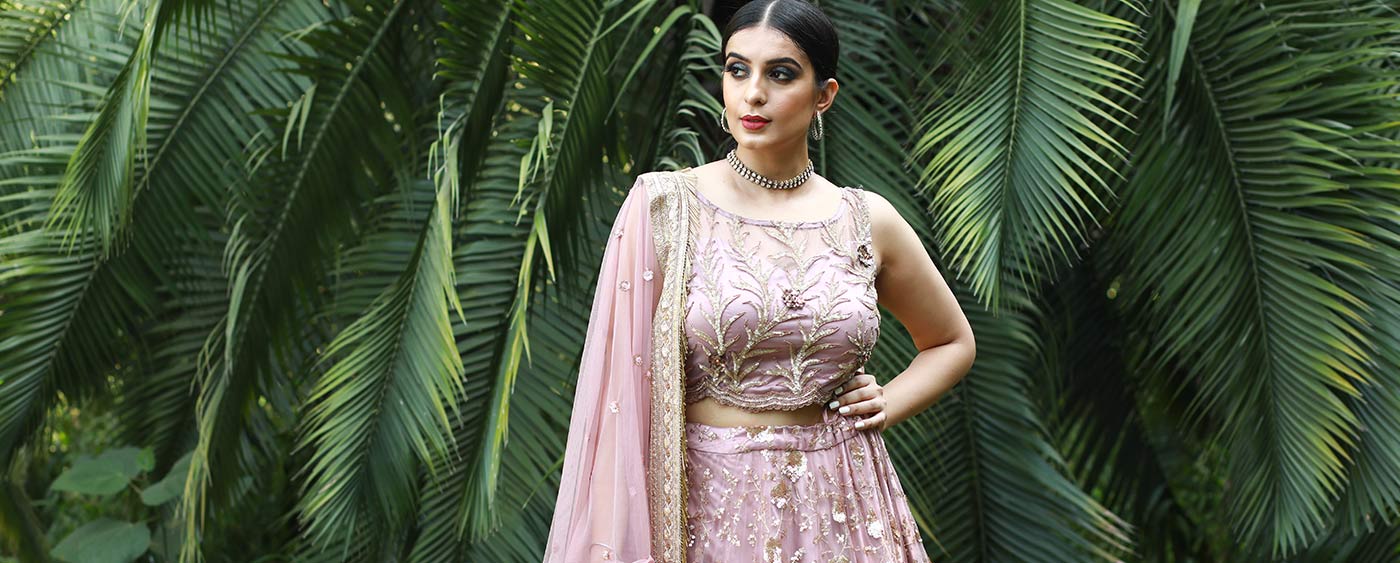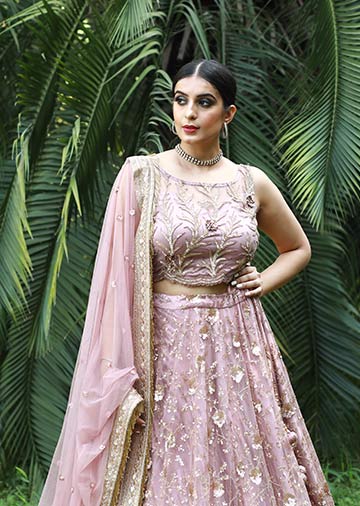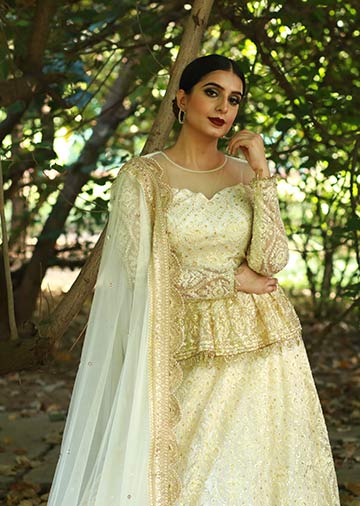
Awadhi Grace
- Fashion
- |
- 27 November 2020
- Priya Kumari Rana
Part vintage and part revivalist fashion brand, Rang Riwaaz dips into the rich archives of Nawabi aesthetics, Lucknowi craftsmanship, Hindu epics, and Raj-era grace to produce rich, embellished pieces that can be passed down generations. We speak to the brand’s founder, fashion designer Jyoti Singh about her unique take on sarees and festivewear, in her latest collection that’s just been launched online with Royal Fables.
.jpg) A saree by Rang Riwaaz
A saree by Rang Riwaaz
Could you tell me about your own journey as a designer – where did you train, what were your interests, and what textiles were you drawn towards?
Speaking of my journey as a designer almost had me believing in the concept of destiny. I got my M. S. in Finance from the University of Wales, however, everyone around me had studied to become a qualified fashion designer. My friends pursued Fashion Design for their graduation, and I would assist them for their projects and fashion shows, researching various textiles and techniques.
My interests were painting, literature, and hand embroidery done by professional artisans. The fabrics which I find myself best creative on I would say are silk, velvets and organza, as I love the texture, richness, and the vintage vibes which come with these fabrics.
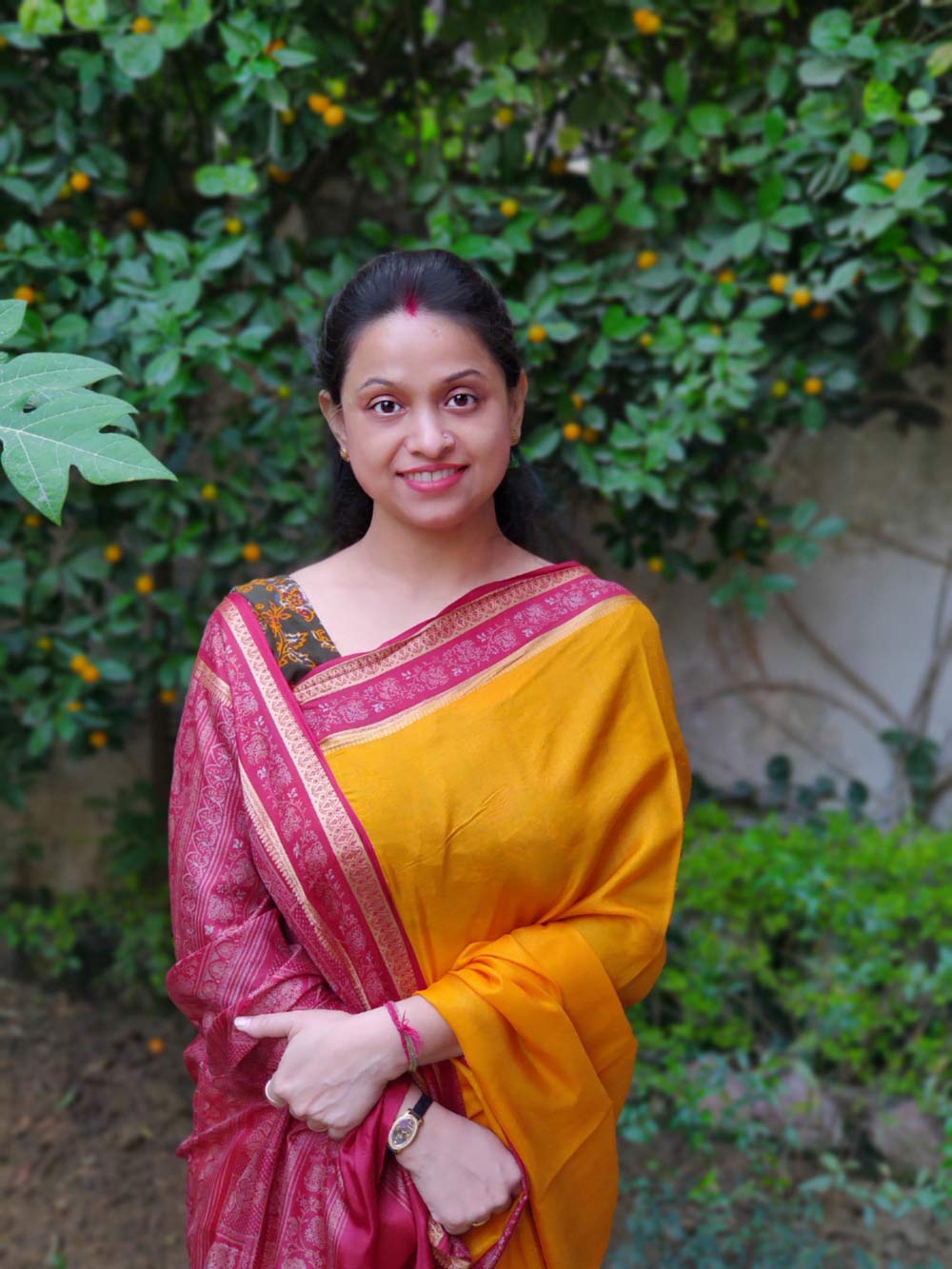 Jyoti Singh, Founder of Rang Riwaaz
Jyoti Singh, Founder of Rang Riwaaz
When you created Rang Riwaaz in 2015, what were the traditional elements of the town you grew up in – Awadh – that you wanted to use in your designs? What were some of these techniques?
Speaking of 2015, as I explained earlier, I was a finance student; I have had the privilege of working for some of the largest financial institutions. However, life was becoming mundane and predictable, and I was living between weekends and vacations. There was this wave of ‘start-up India, stand-up India’, where I thought to start a career with my hobby of painting – oil paintings with flowers, large figures, and mythological scenes.
As for fabrics, I grew up loving silks, velvets, and georgettes. If I were to summarize the Awadh essence of fashion, it would be as rich and vibrant as Umrao Jaan. We would visit the Makbara located in Faizabad which is my mom’s hometown, where Umrao Jaan with Rekha has been shot, the Kanak Bhawan in Ayodhya, and the palace remains of Raja Ramchandra. So growing up it was zardosi on velvets and silks that spelled luxury for us, which is reflected in most of our creations.
.jpg) Rang Riwaaz
Rang Riwaaz
What textiles from Lucknow do you find particularly interesting?
To my mind Lucknow is a place of all seasons, so there is no specific fabric or textile which represents the area. However, the Nawab era has overall influenced the finesse and intricacies of embroidery for the Awadhi style of dressing, and our proximity to Varanasi has definitely been a major influence. Though chikankari continues to reverberate with Lucknow, however, for me it’s velvet shawls with intricate zardosi motifs, and the rustle of silk and tissue is the essence of the region.
Who are the artisans who work for you – are they weavers and embroiderers from that area – and of course weaving as an industry is in danger, so have you 'adopted' any of them to work exclusively with you?
We have a team of hand embroiderers, machine embroiderers, and women folk involved in cottage-style embroideries, finishing, and beading arts along with dyers and hand painters. And of course our team of designers and tailors. Most of them hail from the state of Bihar and a few from Uttar Pradesh. As for the weavers, we have a few partners in Chanderi and Varanasi whom we source from and promote across online platforms, but we’re not really supporting any weavers at a scale or ownership that we have adopted as such.
Our staff has been long-term; some of them have been with us since the beginning, and in fact their experience has been a major guiding force in helping us scale up, as these people come from established designer houses.
Now, during Covid-19, it must be even more difficult – with them not having enough funds – do these weavers need more support from designers and are they getting any government assistance? What do you envisage the future to be for them?
Covid-19 has definitely impacted the luxury clothing industry. Weavers and artisans have suffered as an outcome, and as I say luxury clothing, I would like to differentiate it from fashion. As fashion has continued to evolve, style is more intricate and minimal.
We don’t really see any government aids reaching out to these people, apart from places where NGOs and some royal families are coming to their rescue.
I think we must continue our efforts to support them as the success of any business depends on being accessible online, and the artisans and weavers need support on that front. Sustaining this tide is more of a game of planning that praying so we need to extend our business sense to rural weavers, who need our support. However, as I explain, it’s difficult to reach out to them, so we need platforms where designers get to know such artisans. For us at Rang Riwaaz, in our effort to work with our handloom artisans, we promoted their weaves on our online platforms and mailers to our clients. This year we created handpainted sarees mostly on linen, which received a lot of appreciation. For chanderi blockprints we did mix up light embroideries, making them a little exclusive to suit the personal tastes of our clients.
.jpg) Rang Riwaaz
Rang Riwaaz
Can you tell us about your latest collection?
Our latest collection ‘Riwaayat’ is a tribute to the modern Indian woman who is very well connected to her roots and wears her history with pride and poise.
This collection is a formal online launch with Royal Fables and our own online platforms, of our Signature Style of sarees with epic scenes on the pallu, intricately embroidered, bringing to life the essence of the paintings and scenes we have selected. The colour theme is quite classic with red, wine, green and white.
Can I you give us specific examples of work done on sarees, especially the borders and pallus, and lehengas?
It’s our style to use the entire pallu as a canvas and depict scenes from mythologies or the Mughal era. On one saree, since our theme was Indian mythology, we painted the Shri Ram Durbar on it, and then hand-embroidered it to bring the desired richness. However, to add balance and give an element of surprise we keep the saree sober with rich borders, and add unusual contrasting blouses to offer variety and break the monotony of the scene.
This year we have picked Mughal paintings as our theme, where we have scenes from Mughal palaces. Having elephants march in progression is rather majestic, and when you’re doing a collection for the royals you wouldn’t want to miss out on anything regal.
.jpg) An embellished lehenga by Rang Riwaaz
An embellished lehenga by Rang Riwaaz
How are you influenced by the Nawabi court and its attire in your designs?
In terms of the Nawabi court’s influence, the moment we speak of festivals and weddings, we’re drawn to the richness of that era, and it’s not just the richness and elegance of Nawabi style. I find it sensible and weather appropriate, as it comes so naturally for us in Indian weather to carry a velvet shawl for winter weddings, to have a velvet zardosi blouse or jacket to revive an heirloom gold tissue or pure Banarasi saree. And we always advocate celebrating vintage clothing and heirlooms. Our new creations aim at creating coordinated ensembles, so a typical Rang Riwaaz winter wedding saree set would come with a coordinated embroidered saree, shawl and blouse, which we design with the hope that pieces can be worn independently with other pieces and make the outfit wearable more than once.
The colonial references – do you use French chiffon in your saris – are they hand-painted, or printed?
French chiffon and Indian summers are synonymous for us, we just plain dye them in vibrant colours, hand-paint them, and of course hand embroider them. You name it and we do it.
This year we have definitely missed out on our French chiffon edit with the timing of the pandemic, and having all our artisans away in their hometowns. But our designs are currently being revised to meet the evolved tastes of our clients, so that we have our designs ready, as there are no leftovers from this year, and you never know when Indian divas start getting back to their soirées!
.jpg) Rang Riwaaz
Rang Riwaaz
Lucknow is renowned for its embroidery – what kind of material do you use for your lehengas?
Our choice of material is mostly raw silk or crepe for heavy embroideries, for winter weddings. However, for the summer it’s usually georgettes and tulles with chikankari.
Is each outfit for you a work of art, and should clothes be the kind of clothes that can be passed down the generations?
I would not say that each outfit is a work of art, though it’s definitely a work of great passion. Our focus is on making sustainable clothing, and to that end, we make outfits in two categories: the first is something you would wear yourself, a contemporary piece you can style and match with other items; the second category is heirloom clothing, where the idea is to create outfits that can be passed on, with a timeless grace that doesn’t fade with time. These are the ensembles we hope to see passed down generations.
Where do you retail out of?
Our primary retail avenues have been lifestyle exhibitions and our website www.rangriwaaz.com, with our studio based in Gurgaon.
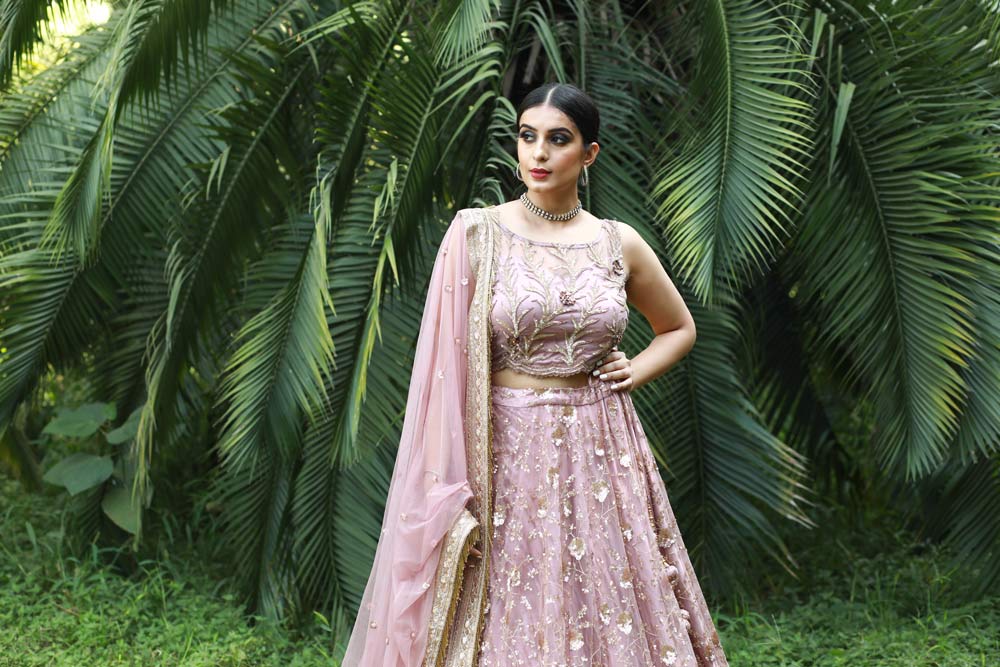 Rang Riwaaz
Rang Riwaaz
Your favourite Rang Riwaaz piece?
It’s difficult to think of one piece as my favourite. While I’m working on something, I’m completely in love with it, and the only reason I hand it over to someone is that I believe that the person sees some of their dreams coming true wearing that outfit, be it a simple chiffon saree or a bridal ensemble in silk and velvet.
FOLLOW US ON INSTAGRAM

Lifestyle Insider is a kind of junction point, connecting people with diverse interests that touch on the more luxurious aspects of lifestyle – fashion, design, travel, food and spirits, art, watches and jewellery, cars, yachts, and aviation, and technology. People today don’t fit into boxes and categories. In our individual ways, we are interested in diverse themes, products, and the challenges that face our world today. You will judge how well this effort of mine caters to your passions and proclivities.
Lifestyle Insider is a showcase of all that is beautiful and luxe. Behind every creation, is a designer, chef, entrepreneur, or a design maison. I have delved into my own appreciation for objetsde luxe that I have admired over the years – be it a love of fashion from the world’s top Parisian and Italian fashion maisons and their ’90s muses, or the care that goes into sari and Indian textile collections in my own family. Growing up on four continents, as the daughter of a former Indian Ambassador, I’ve seen a remarkable array of historic places and met a myriad people. My aim is to bring my world view into this website, a curation of what I find particularly stunning, unique, and newsworthy.
It’s an exciting time for brands all over the world. With change comes opportunity. With the global ‘reset’ and uncertainty on many fronts, there is a chance to write a new script. Let’s be those pioneers.
A bit about me:
A luxury and fashion journalist with 25 years of experience in publishing and magazine journalism, I have edited some of India’s top fashion and luxury magazines. I got my BA in Comparative Literature from UC Berkeley, and went on to receive my Master’s in English and French from the University of Strasbourg, France. I have also studied German and Film. I live in Gurugram, India, and look forward to once again exploring our world with a new-found freedom.
Priya Kumari Rana
Founder and EditorContact Us
Mail us @ lifestyleinsiderindia@gmail.com
